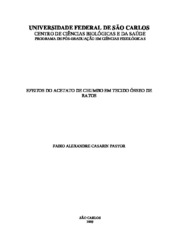Efeitos do acetato de chumbo em tecido ósseo de ratos
Abstract
Lead is a ubiquitous pollutant in the environmental ecosystem which distribution is mainly anthropogenic, come from burning fossil fuels, mining and various industrial products. There
is little knowledge of the involvement of this element on the bone metabolism. This study aimed to determine possible changes in adult rat bone, contaminated with lead acetate during the development phase, through the incorporation of lead in the tissue. Biometric, biophysical, and biomechanical bone parameters were analyzed. The animals were divided into 3 groups: control, 9 rats treated with saline 0.9% (0.1 ml/100g BM) and contaminated groups C-100 and C-200 with 10 animals each, poisoned with lead acetate (100 and 200 mg / kg BM, respectively), once per week for 8 weeks by gastric gavage method. The incorporation of lead was examined with scanning electron microscopy and the concentration of this element in bone tissue with atomic absorption spectrometry with flame. We calculated the bone volume, and from this parameter the bone density was determined. The biomechanical properties of femurs were obtained by three points bending test. Contamination with lead acetate promoted incorporation and increased the concentration of lead in bone for the two doses tested,
however were not sufficient to cause changes in the somatic and bone development of these animals. The dose of 100 mg / kg BM was not enough to cause bone changes and the dose of 200 mg / kg BM caused reduced bone density and strength. Therefore, the results indicate the ability of this element in damage the quality of the bone and maybe, serve as a source for endogenous subsequent contamination.
